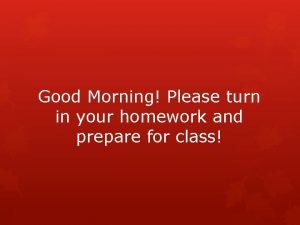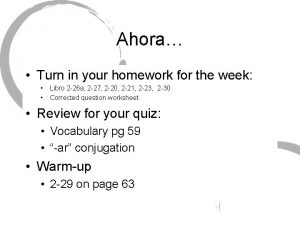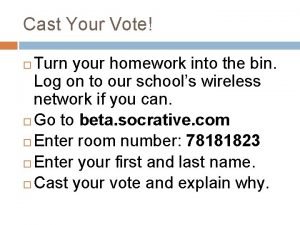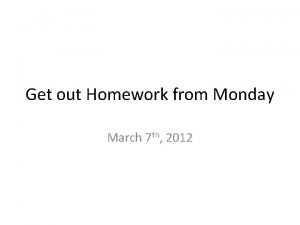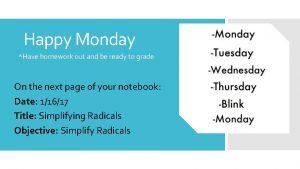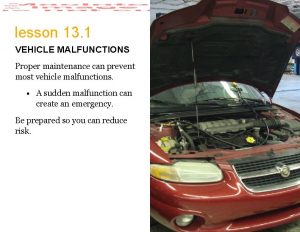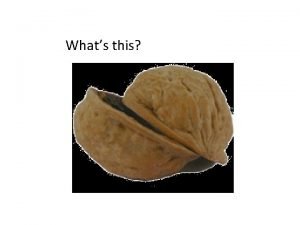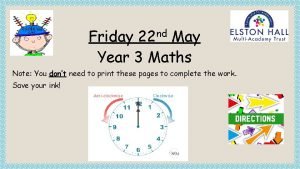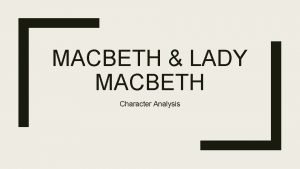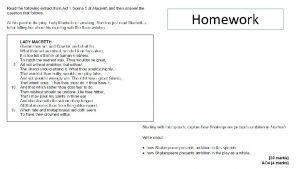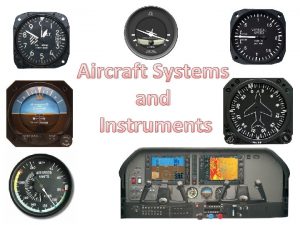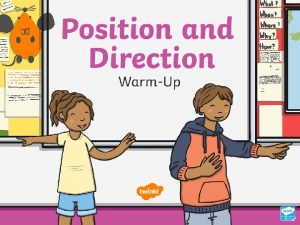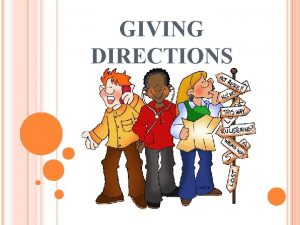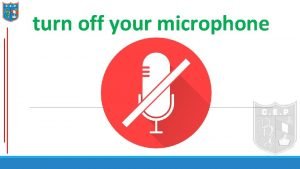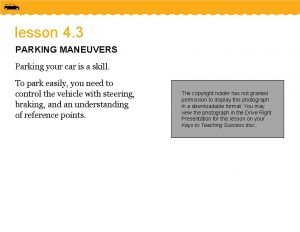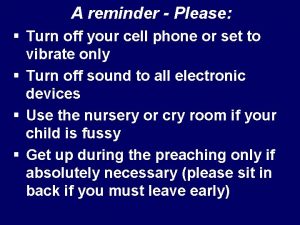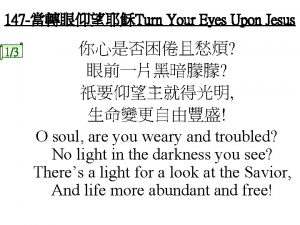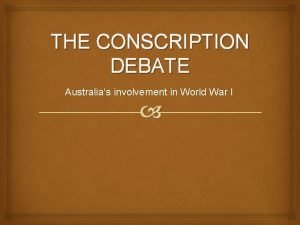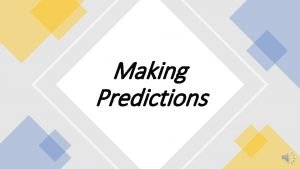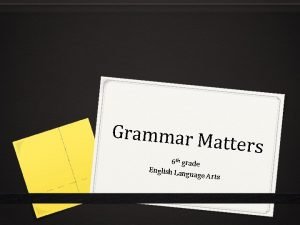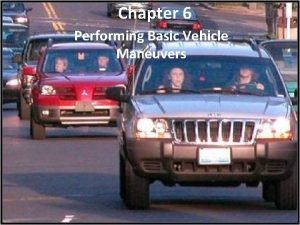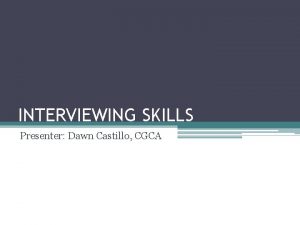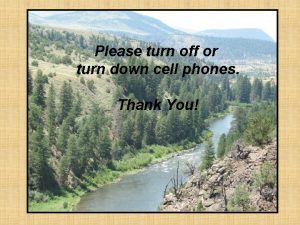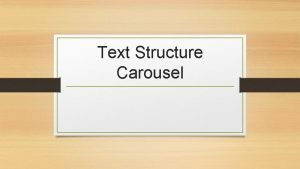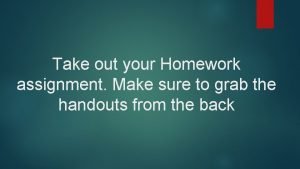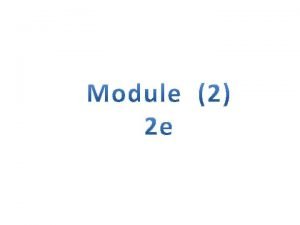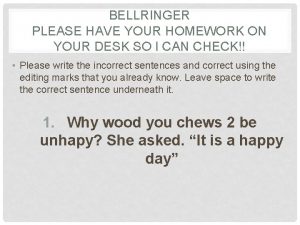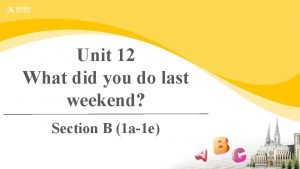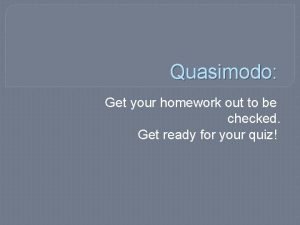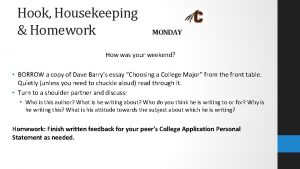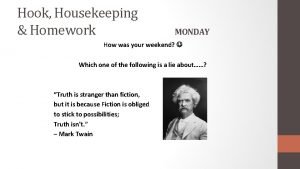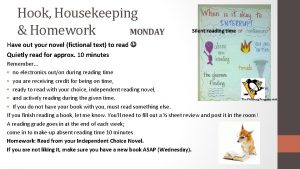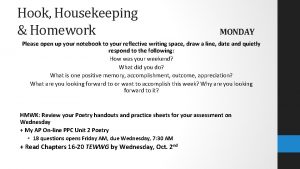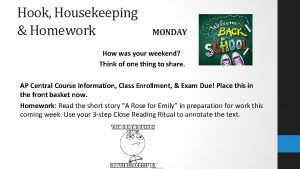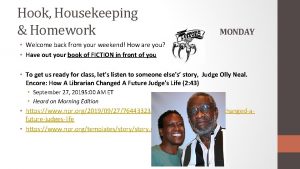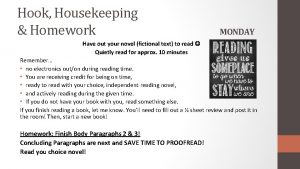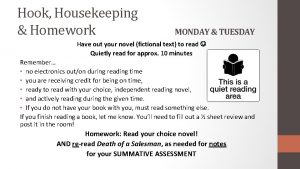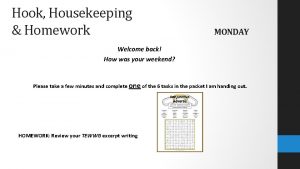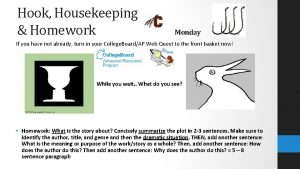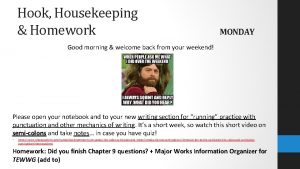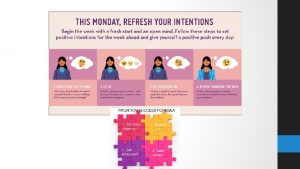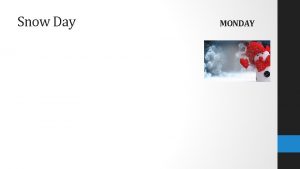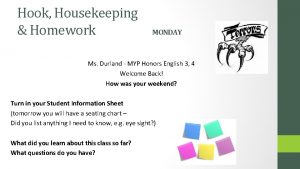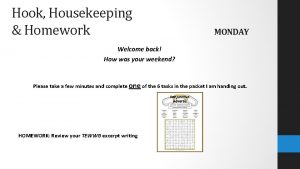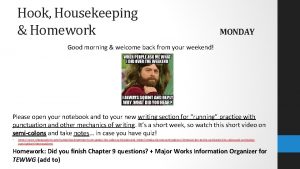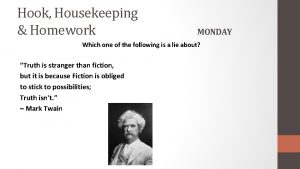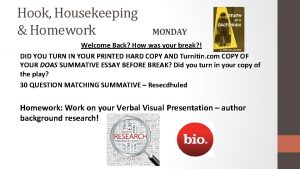Hook Housekeeping Homework MONDAY Turn in your A
















































- Slides: 48

Hook, Housekeeping & Homework MONDAY Turn in your “A Rose for Emily” response! How was your weekend? What is one thing you are looking forward to THIS week? Homework: Complete the PPC (Personal Progress Check) in My AP online classroom by Tuesday, Sept. 10 th 7 AM. Summative Assessment: Review your Unit 1 guide and Incorporating Textual Evidence packet

Past, Present, Future MONDAY • Incorporating Quotes = Information & Practice • Thesis – Claim – So what? – “The Story of an hour” • Character, Setting Details, Point of View & Perspective • Unit: Short Fiction 1 • Structure & Plot • “The Yellow Wallpaper” & “The Story of an Hour” & “A Rose for Emily“ • Complete the PPC (Personal Progress Check) in My AP online classroom by Tuesday, Sept. 10 th 7 AM. • From Close Reading to Defensible Claim with Text Evidence • “The Yellow Wallpaper” & “Girl” • PPC My AP on-line classroom Tuesday, Sept. 10 th 7 AM • Summative In-class Writing Assessment

Unit: Short Fiction 1 Colorado Academic Standards: 2. Reading for All Purposes and 3. Writing & Composition • • Interpret and evaluate complex literature using various critical reading strategies. Understand how language influences the comprehension of narrative, argumentative, and informational texts. Write thoughtful, well-developed arguments that support knowledgeable and significant claims, anticipating and addressing the audience’s values and biases Use a recursive writing process to produce, publish, and update individual or shared writing projects in response to ongoing feedback. Objective: to develop a paragraph that includes 1) a claim that requires defense with evidence from the text and 2) the incorporated evidence itself. Relevance: Reading a wide range of literary texts to build knowledge and to better understand the human experience, and interpretation of text, supported by citing evidence, fosters reading skills and coherent thinking, speaking, and writing, which are priority skills for the workplace and postsecondary settings Essential Questions: How do I create meaning when confronted with ambiguous texts? How does an author use character, setting, structure, and perspective to create meaning in a work of fiction? What are the elements of a good claim (thesis)? How do I incorporate textual evidence into a literary interpretation to support a claim?

Plot & Structure • PLOT: what happens in a narrative; a series of events; arranged conflicts, complications, resolutions creating logical cause-effect relationships; the what & the why; believable (but not necessarily realistic) Five main stages of a conventional narrative: • Exposition: opening section providing background of character, setting, situation, nature of conflict Rising Action: conflicts and complications begin to build. Conflict: the struggle within the plot between opposing forces, taking the form of a character, society, nature, or an aspect of the protagonist’s personality; external: a struggle against some outside force, another character, society as a whole, or some natural force; internal: a conflict between forces or emotions within one character Climax: occurs when the emotional tension or suspense of the plot reaches its peak; includes a turning point where fortunes of the protagonist move or worsen; building to this occupies most of the story, what follows is relatively brief. Falling Action: details the result (or fallout) of the climax or turning point; conflicts are resolved. Denouement (pronounced daynoo-mah): French for “untying the knot; ” very brief; conflict resolved and balance restored; 20 th-21 st century writers often close without this final resolution. In medias res: Latin for “in the middle of the action; ” a Flashback: story starting just as an important event is to take place : describes events that have taken place before the story begins Foreshadowing: hints at things that might happen later in the story • Questions: Is the plot arranged in chronological order, or does it being in medias res, or other progression? Does the plot contain flashbacks or foreshadowing? To what purpose? What is the nature of the conflict? Is it external or internal? How is the conflict resolved? Is there a denouement? If not, why is the story inconclusive? • • • AP Unit 1: Short Fiction STR-1 The arrangement of the parts and sections of a text, the relationship of the parts to each other, and the sequence in which the text reveals information are all structural choices made by a writer that contribute to the reader’s interpretation of a text. 3. A Identify and describe how plot orders events in a narrative. STR-1. A Plot is the sequence of events in a narrative; events throughout a narrative are connected, with each event building on the others, often with a cause-and effect relationship. STR-1. B The dramatic situation of a narrative includes the setting and action of the plot and how that narrative develops to place characters in conflict(s), and often involves the rising or falling fortunes of a main character or set of characters. 3. B Explain the function of a particular sequence of events in a plot. STR-1. C Plot and the exposition that accompanies it focus readers’ attention on the parts of the narrative that matter most to its development, including characters, their relationships, and their roles in the narrative, as well as setting and the relationship between characters and setting.

Activity: Develop & Apply Plot & Structure Purpose: to identify and describe how plot orders events in a narrative and explain the function of a particular sequence of events in a plot. Tasks: Discuss the questions below; be prepared to share (see next) What? How? • What have we noticed so far about the narrative structure (plot) of the story? • How has the author arranged the parts and sections of the text? To what degree does a plot’s ordering of events reflect a chronological sequence? Which plot event(s) seems to break an established chronological sequence, and where does this event fit into the chronology of other events? Why? So what? • How does the sequence of events affect the presentation and/or development of characters and conflict? • How does the sequence of events and the manner in which a text presents those events to a reader affect a reader’s experience with the text? • What is the relationship between a particular sequence of events and a text’s structure as a whole?

Instruction: Obtain “The Yellow Wallpaper” Chronological order • Exposition: rental situation; uneasiness at estate; marital relationship (hint, hint – see next) • Conflict: rest vs. write (husband vs. narrator/wife) – seems relatively “mild” • Rising Action: wallpaper interest – adds complication to situation (rest as the best? ) • Climax: Identifies with woman in paper; strips wallpaper • Falling Action (Suspense): John arrive • Denouement: John faints (shift in “power, ” see next) • Conclusion: Continues creeping – left wondering what happened Foreshadowing: teeth marks; use of “creepy” before she “creeps” Progresses along with the narrator’s illness; with her increased mentally stressed state, we, too, become more aware of the seriousness of the situation, moment by moment; rapid decline - falling action leaves reader in a state confusion/questioning – What happened? Was this “rest” really the correct solution? What? How? • What have we noticed so far about the narrative structure (plot) of the story? • How has the author arranged the parts and sections of the text? To what degree does a plot’s ordering of events reflect a chronological sequence? Which plot event(s) seems to break an established chronological sequence, and where does this event fit into the chronology of other events? Why? So what? • How does the sequence of events affect the presentation and/or development of characters and conflict? • How does the sequence of events and the manner in which a text presents those events to a reader affect a reader’s experience with the text? • What is the relationship between a particular sequence of events and a text’s structure as a whole? Outcome: What is the purpose and effect of structuring the narrative in this way? How can it support a bigger picture, the meaning of the work as a whole? • Sometimes people are the most misunderstood by those who should seemingly be the closest to them. • Marital relationships can be thrown out of balance when dictated by societal norms or traditional gender roles that may oppress a partner. • “A mind that is kept in a state of forced inactivity is doomed to self-destruction. ” • Rigid distinctions of gender roles and divisions can prevent people from developing to their full potential. • A mind plagued with anxiety can deteriorate and begin to prey on itself when it is forced into inactivity

Activity: Develop & Apply We Do – “Review” “The Story of an Hour” Plot & Structure Purpose: to identify and describe how plot orders events in a narrative and explain the function of a particular sequence of events in a plot. Tasks: Discuss the questions below; be prepared to share (see next) What? How? • What have we noticed so far about the narrative structure (plot) of the story? • How has the author arranged the parts and sections of the text? To what degree does a plot’s ordering of events reflect a chronological sequence? Which plot event(s) seems to break an established chronological sequence, and where does this event fit into the chronology of other events? Why? So what? • How does the sequence of events affect the presentation and/or development of characters and conflict? • How does the sequence of events and the manner in which a text presents those events to a reader affect a reader’s experience with the text? • What is the relationship between a particular sequence of events and a text’s structure as a whole? Outcome: What is the purpose and effect of structuring the narrative in this way? How can it support a bigger picture, the meaning of the work as a whole? • Independence, marriage, freedom/confinement, contentment

Activity: Develop & Apply “A Rose for Emily” Plot & Structure Purpose: to identify and describe how plot orders events in a narrative and explain the function of a particular sequence of events in a plot. Tasks: Discuss the questions below; be prepared to share (see next) What? How? • What have we noticed so far about the narrative structure (plot) of the story? • How has the author arranged the parts and sections of the text? To what degree does a plot’s ordering of events reflect a chronological sequence? Which plot event(s) seems to break an established chronological sequence, and where does this event fit into the chronology of other events? Why? So what? • How does the sequence of events affect the presentation and/or development of characters and conflict? • How does the sequence of events and the manner in which a text presents those events to a reader affect a reader’s experience with the text? • What is the relationship between a particular sequence of events and a text’s structure as a whole? Outcome: What is the purpose and effect of structuring the narrative in this way? How can it support a bigger picture, the meaning of the work as a whole? • Tradition/change, death, isolation, compassion, divisions

If time allows: Peer Feedback & Review TASKS: • Swap paragraphs & discuss • Provide written feedback on the following: 1. Claim that requires defense 1. Clear (easy to read & understand) 2. Responds to prompt (on topic) 3. Provides interpretation or defensible position (states an interpretation or arguable position) 4. Includes line of reasoning - literary elements, techniques 5. Other: Author's full name (spelled correctly), “Title, ” Genre 2. Textual evidence itself. 1. 1 – 2 2. specific details 3. in combination (work together) support a specific part of the claim 4. incorporate a variety of strategic transitions (to show text working together)

Review & Release • Plot and the exposition that accompanies it focus readers’ attention on the parts of the narrative that matter most to its development, including characters, their relationships, and their roles in the narrative, as well as setting and the relationship between characters and setting. • What new understanding do you have for analyzing short fiction? Homework: Complete the PPC (Personal Progress Check) in My AP online classroom by Tuesday, Sept. 10 th 7 AM. Summative Assessment: Review your Unit 1 guide and Incorporating Textual Evidence packet

Hook, Housekeeping & Homework TUESDAY Have out your (pink) Class Information and Expectations sheet from the first week of school Go to the bottom and revisit “properly headed” under “Assignments, Due Dates & Assessments” Homework: Summative Assessment: Review your Unit 1 guide and Incorporating Textual Evidence packet Read annotate “Girl” Horse walks into a bar. Bartender says… Why the long face? What did the horse say when it fell? "I've fallen and I can't giddyup!" No long faces today; you may have “fallen” but you CAN “giddyup”!

Past, Present, Future TUESDAY • Incorporating Quotes = Information & Practice • Thesis – Claim – So what? – “The Story of an Hour” • Character, Setting Details, Point of View & Perspective • Structure & Plot • Complete the PPC (Personal Progress Check) in My AP online classroom by Tuesday, Sept. 10 th 7 AM. • Unit: Short Fiction 1 • REVISIST “A Rose for Emily” Prompt - Thesis – Claim • From Close Reading to Defensible Claim with Text Evidence • “Girl” • Summative In-class Writing Assessment

Unit: Short Fiction 1 Colorado Academic Standards: 2. Reading for All Purposes and 3. Writing & Composition • • Interpret and evaluate complex literature using various critical reading strategies. Understand how language influences the comprehension of narrative, argumentative, and informational texts. Write thoughtful, well-developed arguments that support knowledgeable and significant claims, anticipating and addressing the audience’s values and biases Use a recursive writing process to produce, publish, and update individual or shared writing projects in response to ongoing feedback. Objective: to develop a paragraph that includes 1) a claim that requires defense with evidence from the text and 2) the incorporated evidence itself. Relevance: Reading a wide range of literary texts to build knowledge and to better understand the human experience, and interpretation of text, supported by citing evidence, fosters reading skills and coherent thinking, speaking, and writing, which are priority skills for the workplace and postsecondary settings Essential Questions: How do I create meaning when confronted with ambiguous texts? How does an author use character, setting, structure, and perspective to create meaning in a work of fiction? What are the elements of a good claim (thesis)? How do I incorporate textual evidence into a literary interpretation to support a claim?

Activity: Develop & Apply We Do – “Review” Purpose: to understand the expectations for a thesis statement Task 1: AP = Address the Prompt • Did you annotate the prompt? Do it now. • Let’s turn it into a question? Let’s underline some ideas. Task 2: AP = Analysis, Please • Let’s review the Scoring Rubric: Scoring Domains • Did you write a defensible claim presenting an interpretation based on the prompt? • Let’s try this again!

Instruction: Obtain Model Task 1: AP = Address the Prompt The following excerpt is from the novel Lucy, by Caribbean-American author Jamaica Kincaid, published in 1990. In this passage, the narrator describes the beginning of a new phase in her life. Read the passage carefully. Then, in a well-written essay, analyze how Kincaid uses literary elements and techniques to portray the complexity of the narrator’s new situation. What is the narrator’s new situation? Why is it complex? (What is complex about it? ) What literary elements does Kincaid use to portray the complexity of the narrator’s new situation? • Did you annotate the prompt? Do it now. • Let’s turn it into a question? Let’s underline some ideas.

Instruction: Obtain Model Task 2: AP = Analysis, Please Examples that earn a point for thesis (provide a defensible interpretation that establishes a line of reasoning) • “Kincaid, through the use of imagery, em dashes, and repetition, revealed her complex dilemma of wanting to go home or staying [sic] in a newer environment. ” (Minimally acceptable thesis) • “In 1990, Jamaica Kincaid’s novel Lucy, depicts this life change and the narrator’s feelings. Kincaid uses repetition of phrases, diction that illicits [sic] pathos, and a mood of uncertainty and questioning to show the narrator feels unsure and worried about moving from her hometown and how, despite a chance to restart her life, she still wants to go back. ” Examples that do not earn a point for thesis • Restate the prompt • “Kincaid’s narrator make adept use of literary devices when discuss the complexity of her new situation. ” • Do not respond to the prompt • “The narrator in Kincaid’s novel demonstrates the importance of home and belonging. ” • Describe the text or features of the text • “Kincaid uses very detailed description of places and contrasting of those places to develop the narrator’s experience. ”

Review & Release Homework: “Girl” by Jamaica Kincaid - What? How? Why? So what? Purpose: to practice our close critical reading steps and to practice writing a thesis supported by textual evidence Tasks: 1. Read quickly to familiarize yourself with the text (and look up problematic vocabulary) 2. Read again, now for details; annotate for elements of fiction: • Identify and describe specific textual details… • that reveal character, character perspective, and motives • that convey/reveal setting • Identify and describe… • how plot orders events and explain the function of the sequence • the narrator or speaker and explain the function of the point of view 3. Look for patterns in and among characters, setting, plot and point of view Outcome: Develop a new understanding: • What is this story about? Females, relationships, domesticity, sexuality, power, advice, love, worry, oppression… and the list goes on… • But, what is it really saying? Consider some of the words above to reflect on the meaning of the work as a whole. • Summative Assessment: Review your Unit 1 guide and Incorporating Textual Evidence packet

Hook, Housekeeping & Homework WEDNESDAY Welcome to wacky Wednesday! • Why can’t your nose be 12 inches long? • Because than it would be a foot! • Homework: Summative Assessment Review - Unit 1 Guide and Incorporating Textual Evidence packet

Past, Present, Future WEDNESDAY • • Incorporating Quotes = Information & Practice Thesis – Claim – So what? – “The Story of an Hour” Character, Setting Details, Point of View & Perspective, Structure & Plot Complete the PPC (Personal Progress Check) in My AP online classroom • REVISIST “A Rose for Emily” Prompt - Thesis – Claim • Unit: Short Fiction 1 “Girl” • From Close Reading to Defensible Claim with Text Evidence • Summative In-class Writing Assessment

Unit: Short Fiction 1 Colorado Academic Standards: 2. Reading for All Purposes and 3. Writing & Composition • • Interpret and evaluate complex literature using various critical reading strategies. Understand how language influences the comprehension of narrative, argumentative, and informational texts. Write thoughtful, well-developed arguments that support knowledgeable and significant claims, anticipating and addressing the audience’s values and biases Use a recursive writing process to produce, publish, and update individual or shared writing projects in response to ongoing feedback. Objective: to develop a paragraph that includes 1) a claim that requires defense with evidence from the text and 2) the incorporated evidence itself. Relevance: Reading a wide range of literary texts to build knowledge and to better understand the human experience, and interpretation of text, supported by citing evidence, fosters reading skills and coherent thinking, speaking, and writing, which are priority skills for the workplace and postsecondary settings Essential Questions: How do I create meaning when confronted with ambiguous texts? How does an author use character, setting, structure, and perspective to create meaning in a work of fiction? What are the elements of a good claim (thesis)? How do I incorporate textual evidence into a literary interpretation to support a claim?

Instruction: Obtain Here’s from your Peers • In the short story, “A Rose for Emily, ” published in 1930, William Faulkner uses detail and imagery to establish a dreary and abandoned setting which helps convey that the townspeople were afraid of Emily Grierson yet still held respect for her and her privacy. • Section I + contrast of setting/old vs. new • In Section I of “A Rose for Emily” by William Faulkner in 1930, the author conveys Emily’s isolation and obvious lack of interest in conforming to the norms of her town by presenting her house as a unkempt entity compared to others. • Awkward wording + lack of key term “setting” • Within the short story “A Rose for Emily, ” the author, William Faulkner, uses the first person point of view of a townsperson in order to emphasize the contrast between the town and Emily and convey feelings of empathy for Emily.

Activity: Develop & Apply “Girl” by Jamaica Kincaid - What? How? Why? So what? Details: What did you notice? • • character, character perspective, and motives setting plot orders events, function of the sequence narrator or speaker and explain the function of the point of view Patterns: What stood out to you as most important and interconnect? • characters, setting, plot and point of view New understanding: What is the purpose and effect of the work in its entirety? • meaning of the work as a whole – So what could the piece “mean”? • universal concepts and messages – So what’s a “big” idea? • So what does is saying about being a human being in this world?

Big Ideas Models • Sex (and race) are factors in conforming to social norms; we are not free to be ourselves; we must “behave” to these norms to be seen as successful and to be accepted. • A mother’s influence and opinions are powerful and long lasting; they deeply affect a child and the way in which she sees herself. • Community plays a large role in some people’s lives, and social standing (within that community) bears a great deal of weight. A woman’s reputation and respectability determines the quality of their life in the community. • In “Girl, ” femininity revolves around maintaining a home, suggesting that woman are restricted by particular rules of femininity and their behaviors policed by society.

Activity: Develop & Apply But, darn it, what if there is a prompt…? Purpose: to practice developing a paragraph that includes 1) a claim that requires defense with evidence from the text and 2) the evidence itself (Skill 7. A) Tasks: Dissect the prompt. Let’s do some prewriting and drafting for a paragraph that makes a claim about “Girl” accompanied by textual evidence that supports that claim. Now follow a similar writing process and draft your own paragraph that establishes a claim and supports that claim with evidence. Make a claim that presents a defensible interpretations - Line of reasoning • Select textual evidence • The short prose poem* “Girl’” by Caribbean-American author Jamaica Kincaid was published in 1978. In this story, a narrator recounts a variety of how -tos, to-dos and other pieces of advice, warnings and comments regarding life issues and concerns. Re-consider the passage carefully. Then, in a well-written essay, analyze how Kincaid uses narrative point of view to express the characters’ complex situation. What’s the narrative POV? What’s the complex situation? How does the POV show the situational complexity? *A prose poem reads like prose, but it uses the elements & techniques of conventional poetry (vs. the rules of standard modern prose)

Activity: Develop & Apply Let’s try! Claim The short prose poem “Girl’” by Caribbean-American author Jamaica Kincaid was published in 1978. In this story, a narrator recounts a variety of how-tos, to-dos and other pieces of advice, warnings and comments regarding life issues and concerns. Re -consider the passage carefully. Then, in a well-written essay, analyze how Kincaid uses narrative point of view to express the characters’ complex situation. What’s the narrative POV? What’s the complex situation? How does the POV show the situation’s complexity? Claim: The…. told through… revealing…. suggesting…. FIRST, what do you think you want to respond to the prompt? Write a rough claim. Now go back into the text and label some lines of reasoning to help you with your claim. Now number the main ones you think you want to use in the order you would use them.

Activity: Develop & Apply Let’s try! Claim The short prose poem “Girl’” by Caribbean-American author Jamaica Kincaid was published in 1978. In this story, a narrator recounts a variety of how-tos, to-dos and other pieces of advice, warnings and comments regarding life issues and concerns. Re-consider the passage carefully. Then, in a well-written essay, analyze how Kincaid uses narrative point of view to express the characters’ complex situation. What’s the narrative POV? What’s the complex situation? How does the POV show the situation’s complexity? Claim: The…. told through… revealing…. suggesting…. Model: The short prose poem “Girl, ” by Jamaica Kincaid, presents a somewhat stream-ofconsciousness narrative by a mother giving advice to her young (potentially rebellions) daughter suggesting the importance of how a female must behave in their traditional society. Model: The short prose poem “Girl, ” by Jamaica Kincaid, presents a somewhat stream-ofconsciousness narrative by a mother giving advice to her young (potentially rebellions) daughter. Kincaid's use of punctuation and imperatives, interrupted only a few times with questions and italics, creates a principally didactic (but sometimes bitter) tone suggesting the importance of how a female must behave in this more traditional, patriarchal society.

Activity: Develop & Apply Let’s try! Point followed by Text Evidence The short prose poem “Girl’” by Caribbean-American author Jamaica Kincaid was published in 1978. In this story, a narrator recounts a variety of how-tos, to-dos and other pieces of advice, warnings and comments regarding life issues and concerns. Re-consider the passage carefully. Then, in a well-written essay, analyze how Kincaid uses narrative point of view to express the characters’ complex situation. Point/Reasoning 1: Kincaid’s narrative presents… as one long sentence. The use of. . Textual Evidence 1: For example… Kincaid’s narrative is mostly presented as one long sentence from the mother. The repeated use of the semi-colon shows… creates the feeling that…. The purpose… The effect…

Activity: Develop and Apply Model: The short prose poem “Girl, ” by Jamaica Kincaid, presents a somewhat stream-of-consciousness narrative by a mother giving advice to her young (potentially rebellions) daughter. Kincaid's use of punctuation and imperatives, interrupted only a few times with questions and italics, creates a principally didactic (but sometimes bitter) tone suggesting the importance of how a female must behave in this more traditional, patriarchal society Kincaid’s narrative is mostly presented as one long sentence from the mother. The repeated use of the semi-colon shows… creates the feeling that…. The purpose… The effect… The narrative is interrupted, however, two times with italics. This suggests… The effect…

Review & Release 1. 2. 3. 4. 5. 6. 7. Tomorrow you will write a claim as if you were being graded on a full 40 -minute essay. You will follow that claim with one well-organized paragraph that supports your claim and addresses your first line of reasoning. This should start with a topic sentence that makes a point about your claim (1 st reason). The topic sentence should be followed by textual evidence. The textual evidence must be incorporated seamlessly and punctuated correctly. Then, you need to explain and elaborate (how does this evidence support your point). You must follow with at least one more piece of textual evidence and explanation/elaboration. Finally, include a concluding sentence that ties all of your ideas in this paragraph together. Homework: Summative Assessment Review • • Unit 1 Guide (skills & questions) Scoring Rubric Models and Practice Incorporating Textual Evidence packet

AP = Ambiguity Possible Address the Prompt Analysis, Please Always Poetry Also Prose Applied Practice “Anything’s” Possible? Absolute Paradise

Activity: Peer Feedback & Review TASKS: • Swap paragraphs & discuss • Provide written feedback on the following: 1. Claim that requires defense 1. Clear (easy to read & understand) 2. Responds to prompt (on topic) 3. Provides interpretation or defensible position (states an interpretation or arguable position) 4. Includes line of reasoning - literary elements, techniques 5. Other: Author's full name (spelled correctly), “Title, ” Genre 2. Textual evidence itself. 1. 1 – 2 2. specific details 3. in combination (work together) support a specific part of the claim 4. incorporate a variety of strategic transitions (to show text working together)

Hook, Housekeeping & Homework Question: What is black and white and read all over? Answer: A newspaper I can’t wait to read the responses you write today! Homework: Anticipation Guide for TEWWG due tomorrow (Friday)! Hist/Bio Research for TEWWG due Monday

Past, Present, Future THURSDAY • • • Incorporating Quotes = Information & Practice Thesis – Claim – So what? – “The Story of an Hour” Setting Details, Point of View & Perspective, Structure & Plot Complete the PPC (Personal Progress Check) in My AP online classroom Prompt - Thesis – Claim – “Girl” • Unit 1 : Short Fiction = Summative In-class Writing Assessment • From Close Reading to Defensible Claim with Text Evidence • Introduction to a novel Their Eyes Were Watching God by Zora Neale Hurston • Unit 2: Poetry

Unit: Short Fiction 1 Colorado Academic Standards: 2. Reading for All Purposes and 3. Writing & Composition • • Interpret and evaluate complex literature using various critical reading strategies. Understand how language influences the comprehension of narrative, argumentative, and informational texts. Write thoughtful, well-developed arguments that support knowledgeable and significant claims, anticipating and addressing the audience’s values and biases Use a recursive writing process to produce, publish, and update individual or shared writing projects in response to ongoing feedback. Objective: to develop a paragraph that includes 1) a claim that requires defense with evidence from the text and 2) the incorporated evidence itself. Relevance: Reading a wide range of literary texts to build knowledge and to better understand the human experience, and interpretation of text, supported by citing evidence, fosters reading skills and coherent thinking, speaking, and writing, which are priority skills for the workplace and postsecondary settings Essential Questions: How do I create meaning when confronted with ambiguous texts? How does an author use character, setting, structure, and perspective to create meaning in a work of fiction? What are the elements of a good claim (thesis)? How do I incorporate textual evidence into a literary interpretation to support a claim?

Activity: Summative Assessment You may have out and use the following: • Unit 1 Guide (skills & questions) • Scoring Rubric • Incorporating Textual Evidence packet You need out a sheet or two of loose-leaf notebook paper and a writing utensil (preferable pen) Write a proper 4 line heading on your paper; assignment title = U 1 SF: Summative Yes, you may write on the prompt and excerpt page. Staple this on top of your written work to turn in.

Activity: Summative Assessment 1. Read annotate the prompt 2. Briefly/quickly familiarize yourself with the text (NO vocab. look up) 3. Read closely and annotate the text • details based on the prompt – patterns – new understanding 4. Write a rough thesis / claim 5. Annotate your annotations – star, number, arrow an outline what details you will use in what order to prove your claim 6. Write your thesis neatly and clearly (indent like it is its own mini-paragraph) 7. Write your paragraph (indent) • Stop periodically and re-assess 8. Proofread! AND double check your claim – Double check your evidence and how well you incorporated it 9. Staple & Turn in

Activity: Summative Assessment 1. Write a defensible claim as if you were being graded on a full 40 -minute essay (indent) 2. Follow that claim with one well-organized paragraph that supports your claim and addresses your first line of reasoning (indent) 3. Start with a topic sentence that makes a point about your claim (1 st reason) 4. Follow this with textual evidence • Incorporate this evidence seamlessly and punctuate correctly – USE (paragraph numbers) here since they are #ed 5. Then, explain and elaborate (how does this evidence support your point). 6. You must include at least one more piece of textual evidence and explanation/elaboration. 7. Finally, include a concluding sentence that ties all of your ideas in this paragraph together.

Model With narrative perspective, connotative diction, contrasting details, and varied syntax, Charlotte Perkins Gilman reveals how a woman might be thrown out of balance by oppressive societal norms and traditional gender roles. In the opening excerpt of the short story, the first person narration, while limiting, establishes a benevolently controlling, almost condescending, relationship. The narrator explains that, when she questions why their newly rented house is so inexpensive and has been empty for so long, her husband “laughs at [her], of course, but one expects that in marriage” (1). Through the narrator’s/wife’s point of view, it is suggested that her husband does not take her seriously. The irony presented, that a wife might be laughed at by her spouse for a seemingly reasonable inquiry, establishes for the reader a disconnect that exists in this relationship. She has given into what must be the roles within a marriage; men are powerful and knowledgeable, and women are weak and lack understanding. Also, the use of the indefinite (impersonal) pronoun “one, ” shows her pragmatic acceptance of the situation. In fact, the reader does not know her name; they, too, feel the lack of identity that this woman feels. In this same opening section of the story, the narrator’s illness is revealed. She explains that “ – John says the very worst thing I can do is to think about my condition… So I will let it alone and talk about the house” (1). Here, in contrast, her husband shows an interest in her health and well-being, but it is still an authoritative voice, telling her to be passive. Once again, this emphasizes the easy submission of the narrator to her husband’s will. Then, with the ellipses, she interrupts her reflections on her “condition” to abruptly change the subject to that of the house. She does not appear to have any argument, or else has curbed her disagreement to fight against his desire, allowing him to dictate how she should handle her own physical and mental state. This helps the reader begin to see her brooding, uneasy feelings. By conveying the story through the eyes of the wife, Gilman, who wrote this in 1899, can explore the negative effects of oppression in an era lacking gender quality. (250 -350)

Review & Release • Double check your claim – Double check your evidence and how well you incorporated it • Did you staple & turn in your assessment? Homework: Anticipation Guide for TEWWG due tomorrow (Friday)! Hist/Bio Research for TEWWG due Monday

Hook, Housekeeping & Homework Your “Ticket in” = Anticipation Guide for TEWWG due NOW If you didn’t do it, get comfortable outside the room while you do Homework: Hist/Bio Research for TEWWG due Monday Read Chapters 1 – 6 by Wednesday Sept. 18 th

Activity: Pre-Reading Personal Reflection Purpose: to examine some of our own belief systems prior to reading a text that incorporates some of these ideas Tasks: Four Corners • After a statement is selected, move to the corner of the room that best reflects your opinion: Strongly Agree, Strongly Disagree, Disagree • Take a look at where your classmates stand how we have varied opinions about similar ideas Outcome: What predictions do you have about what this novel is about?

Past, Present, Future • Short Fiction • Details – Patterns – New Understanding: What? How? Why? So what? • Character, Setting, Point of View & Perspective, Structure & Plot • Prompt - Thesis – Claim – Textual Evidence - Incorporating Quotes • MC Practice: PPC (Personal Progress Check) in My AP online classroom • = Summative In-class Writing Assessment • Introduction to a novel Their Eyes Were Watching God by Zora Neale Hurston • Check it out! Preview the text & make predictions • Listen to Chapter 1 with Reading Guide • Read Chapters 1 -6 TEWWG & respond to the Reading Guide Questions with short answers • Their Eyes Were Watching God – a novel by Zora Neale Hurston • Unit 2: Poetry


Life Is a Journey: TEWWG Standard Colorado Academic Standard 2. Reading for All Purposes 1. Literary criticism of complex texts requires the use of analysis, interpretive, and evaluative strategies; 2. Interpreting and evaluating complex informational texts require the understanding of rhetoric, critical reading, and analysis skills e. obtain and use information from text and text features to answer questions, perform specific tasks, and identify/solve problems. Objective: you will be able to examine the opening chapter of TEWWG for details of character and discover responses to your initial questions Relevance: What we say and how we say it, our actions, our attitudes, and our appearances leave impressions on others. Essential Questions: What is significant in developing our psychological and moral growth? What kinds of experiences lead to the discovery of self-identity? • • • Interpreting character description and perspective Character evolution throughout a narrative Conflict and plot development Interpreting symbolism Identifying evidence and supporting literary arguments

AP = Always Preview Activity: Preview the Text Purpose: to familiarize ourselves with the text Tasks: Preview the text 1. Look at the front cover. What do you notice? What inferences can you make about any images provided? About the title? About the quality of the text? 2. Look at the back cover. What information is provided? What do you notice or what stands out to you? Why? 3. Flip through the first few pages of the book. What information is provided? When was the book first published? Is there a dedication page, reviews, introduction or preface, or other information? 4. Flip through the book. Are there chapters, sections, or parts? If so, are these titled or numbered? How large is the font? How much print is on a page? 5. How long is the text? On what page does it start? On what page does it end? How long is the actual book? 6. Is there any additional information (e. g. a glossary, information about the author, historical or other footnotes, reading guides, etc. ) at the end? 7. Flip to a random page and read a paragraph. What do you notice about writing style, characters, setting, vocabulary, etc. ? Outcome: What structures does the text provide that could be helpful to you? What new predictions do you have about what this novel is about?

Instruction: Obtain We Do Purpose: you will be able to examine the opening chapter of TEWWG for details of character and discover responses to your initial questions Tasks: Large Group Close Reading Ritual TEWWG Chapter 1 • Listen to an audio version of the first few paragraphs in order to get a feel for the language http: //nelsonica. pbworks. com/w/page/25869035/Their%20 Eyes%20 Were%20 Watching%20 God%3 A%20 Audio http: //mrstedorasclassroomonline. weebly. com/their-eyes-were-watching-god-audio-files. html What did you notice as you read Chapter 1 (ideas and interests)? (see next)

Reading Guide Chapters 1 -4 1. Who is the main character? 2. What is her situation at the beginning of the novel? 3. What was Janie's most noticeable physical characteristic? 4. Who was Janie's best friend? 5. After Chapter 1, how is the story told? 6. Why did Janie marry Logan Killicks? 7. What was Janie's idea of love before she was married? 8. What happened to Nanny shortly after Janie was married? 9. How did Janies's and Logan's relationship change? 10. What did Janie discover about love? 11. Describe Joe Starks. 12. What did Janie do shortly after she met Joe Starks?

Review & Release Re-consider the anticipation guide, what are you noticing so far that relates to the novel? Re-consider the predictions you made, how are they “shaking out” so far?
 Turn in your homework
Turn in your homework Turn in your homework
Turn in your homework Cast your vote war of 1812 answer key
Cast your vote war of 1812 answer key I didn't have time to finish my homework last night
I didn't have time to finish my homework last night Homework for monday
Homework for monday Square root of 150 simplified
Square root of 150 simplified If your vehicle malfunctions turn on your hazard lights
If your vehicle malfunctions turn on your hazard lights You can't turn left
You can't turn left Hellhound macbeth
Hellhound macbeth Answer. go straight turn left turn right
Answer. go straight turn left turn right Turn the arrow 1/4 turn clockwise
Turn the arrow 1/4 turn clockwise Lady macbeth characterization
Lady macbeth characterization Turn hell hound turn
Turn hell hound turn It's on your left
It's on your left Themes about guilt
Themes about guilt Atomatoeflames
Atomatoeflames One quarter turn clockwise
One quarter turn clockwise Go straight ahead and turn left
Go straight ahead and turn left Homework oh homework i hate you you stink
Homework oh homework i hate you you stink Homework oh homework i hate you you stink
Homework oh homework i hate you you stink Parts of a poem
Parts of a poem Homework i love you poem
Homework i love you poem Alitteration definition
Alitteration definition Literal language examples
Literal language examples Give us your hungry your tired your poor
Give us your hungry your tired your poor 當轉眼仰望耶穌turn your eyes upon jesus
當轉眼仰望耶穌turn your eyes upon jesus Please turn off the microphone
Please turn off the microphone When leaving a parallel parking space you
When leaving a parallel parking space you Your turn image
Your turn image Please turn off your cell phone in church
Please turn off your cell phone in church 當轉眼仰望耶穌 歌词
當轉眼仰望耶穌 歌词 Your turn next
Your turn next Come on come on turn your radio on
Come on come on turn your radio on It's your turn to make predictions
It's your turn to make predictions Your turn
Your turn Always prepare to straighten your vehicle after a turn by
Always prepare to straighten your vehicle after a turn by The now its turn.
The now its turn. Now it's your turn write
Now it's your turn write Now it's your turn to interview or be interviewed
Now it's your turn to interview or be interviewed The cat crept through the dark house
The cat crept through the dark house Please turn off your cell phone announcement
Please turn off your cell phone announcement Being a clown isn't all fun and games
Being a clown isn't all fun and games Take out your homework
Take out your homework How often do you do homework
How often do you do homework Please put your homework my desk
Please put your homework my desk What did your partner do last weekend
What did your partner do last weekend Vicente y francisco / jugar / al vóleibol los domingos
Vicente y francisco / jugar / al vóleibol los domingos Take out your homework
Take out your homework Please your homework this afternoon
Please your homework this afternoon
